Japan readies ‘last hope’ measures to stop falling births
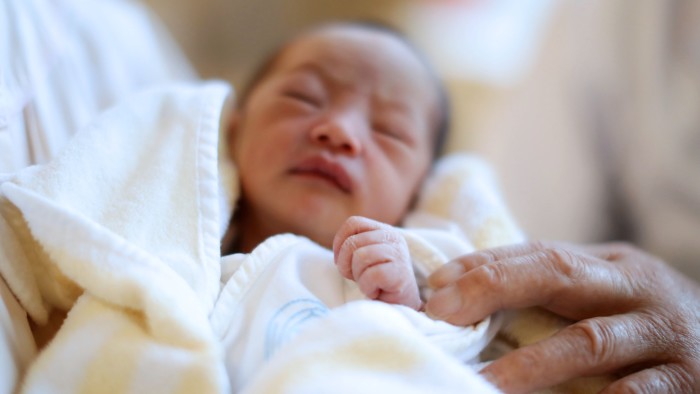
Roula Khalaf, Editor of the FT, selects her favourite stories in this weekly newsletter.
After seven decades in business, Osaka art supplies company Tsuboyone is preparing to shut down next month. Japan’s shrinking student population has gradually reduced the market for the palettes, pencil sharpeners, brush buckets and other products it sells to schools and art colleges.
The small company was founded in 1949 — the same year Japan logged a record 2.69mn births amid the postwar baby boom. The estimate for last year was under 800,000, less than a third of the peak.
Faced with this stark reality, coupled with rising costs of plastic materials and the blow from the Covid-19 pandemic, the 12-person operation will cease to exist at the end of March.
“There are not many positive factors” on the horizon, Tsuboyone president Shuji Omori said with resignation.
Japanese prime minister Fumio Kishida hopes to change the demographic trend with what he has promised will be an “unprecedented” set of measures.
Underscoring the gravity of the challenge in a parliamentary speech on January 23, he said the world’s third-largest economy was “on the brink” of social dysfunction.

This article is from Nikkei Asia, a global publication with a uniquely Asian perspective on politics, the economy, business and international affairs. Our own correspondents and outside commentators from around the world share their views on Asia, while our Asia300 section provides in-depth coverage of 300 of the biggest and fastest-growing listed companies from 11 economies outside Japan.
But with its childbearing-age population also shrinking, Japan faces a fundamental question: is it even possible to reverse the decline? The answer would be relevant to a host of east and south-east Asian countries confronting similar trends.
Japan has been stewing over the problem for decades and has addressed it before, earning praise for some policies. Yet the pace of decline is accelerating. Births fell below 1mn for the first time in 2016. Six years later, the figure dipped below 800,000 — eight years earlier than expected.
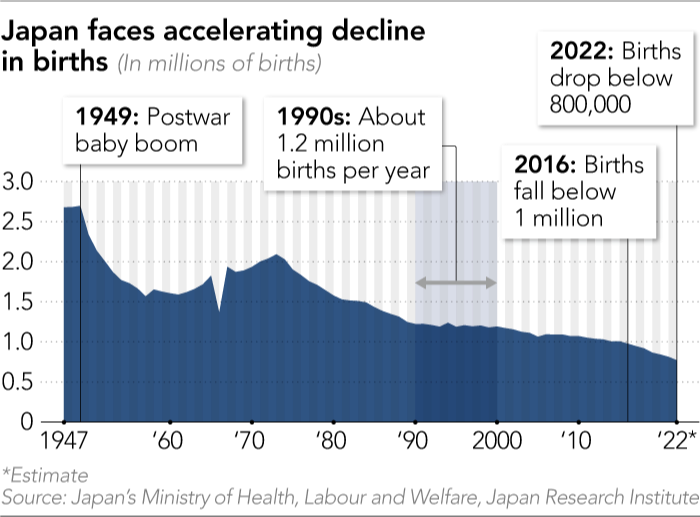
The average annual decline over the five years through 2021 was 3.65 per cent, much faster than the 1.44 per cent for the five years through 2016. The pandemic also appears to have delayed couples’ decisions to marry and start families.
Businesses such as Tsuboyone face dimming sales and hiring prospects as an average of 430 public schools closed permanently each year over the decade through 2020. In another worrying trend — and in a sign of the dysfunction Kishida fears — some rural towns struggle to find enough candidates for local elections. With 29 per cent of the population aged 65 or older, the burden on public finances is increasing amid slow economic growth.
While the absolute number of potential parents is dropping, studies also show that many are wary of the financial toll.
In a 2021 survey, 53 per cent of respondents raised the high cost of raising children, including education, as a reason for having no or fewer children, according to the National Institute of Population and Social Security Research. Forty per cent said they were already too old to have more children.
Kishida emphasised the urgency. “The need to address the issue of children and child-rearing policies is a challenge that cannot be postponed,” he said. “We must create a children-first economic society and reverse the birth rate.”
The prime minister said the plan was to double the budget for child-rearing policies, focusing on three pillars: economic support, child care services and reform of working styles.

The details have yet to be revealed. But the first pillar suggests there will be an expansion of financial aid, such as increasing or broadening allowances for households with children.
At present, the government offers ¥10,000 to ¥15,000 ($75 to $111) a month for each child until graduation from junior high school (age 15), with some limitations on higher-income families.
Government officials say the second pillar will mean strengthening the quantity and quality of child care, including after-school care and services for sick children, as well as an expansion of post-partum services.
The third pillar is likely to involve improvements to the parental leave system and other steps that would create a work environment more conducive to having children.
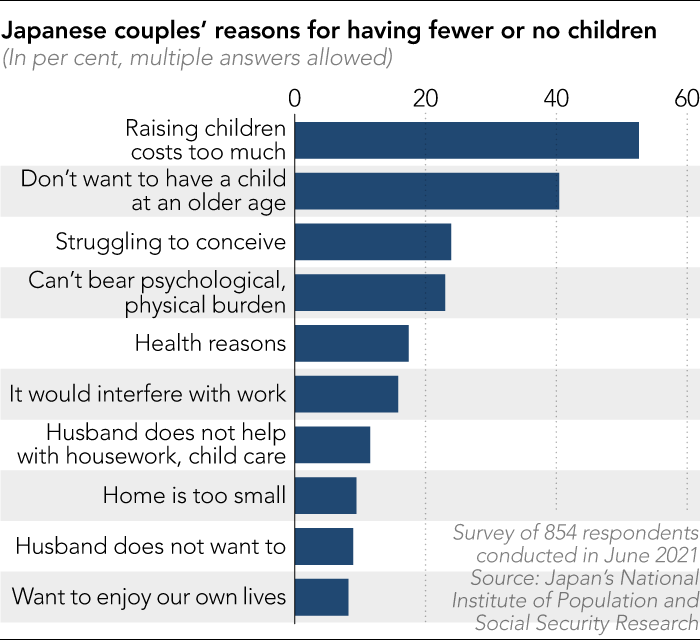
Yet, while few deny that Japan has an ageing-population problem, Kishida’s pledge has sparked a debate.
Some say the ruling Liberal Democratic party’s move is too little, too late. Others question how the programmes would be financed, especially with the government also planning to increase defence spending.
Kenta Izumi, leader of the opposition Constitutional Democratic Party of Japan, argues there are other priorities as well. He has called for reform of the higher education system, such as making university tuition free or less expensive and reviewing loan-based scholarships that impose debt on the young.
Izumi also says that one of the reasons for the low birth rate is that in Japan the burden of housework and childcare disproportionately falls on women. “Let’s change the mindset of all men,” he has suggested.
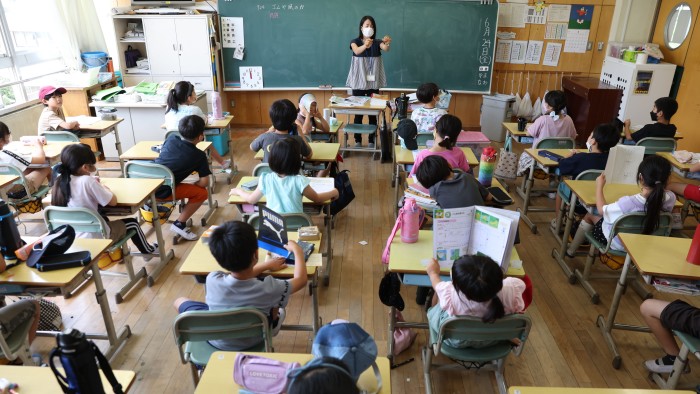
Separately, the Tokyo Metropolitan Government has announced its own measures. Among them is a monthly allowance of ¥5,000 for every child up to the age of 18, regardless of household income. The payments are due to start in January 2024.
“What we know from various surveys is that the reason people hesitate to have the number of children they would like is that it costs a lot of money to raise them, including the cost of education,” Tokyo governor Yuriko Koike told reporters in January. “I think the message that the metropolitan government will support them seamlessly from age 0 to 18 would trigger a major reversal of the trend.”
The prime minister has said he will present specific measures by June.
Some experts, meanwhile, say child-rearing and broader economic policies should be closely linked.
“Looking at the economy over the past 30 years since the burst of the bubble economy, every time the economy has worsened, it has taken a toll on the younger generation,” said Takumi Fujinami, advanced senior economist at the Japan Research Institute, referring to depressed wages and a shift away from lifetime employment towards more temporary positions.
“The result of this has now become apparent in the declining birth rate. So even if the government gives a small amount of benefits, without solving this problem, people will naturally think, ‘There is nothing we can do with just this [amount of money].’
“At the end of the day, I don’t think the birth rate will improve unless the economic environment improves.”
Likewise, echoing the opposition’s argument about women, some experts say the situation is unlikely to improve without fundamental changes in conditions for female workers.
“Gender equality is important in terms of helping women to feel more secure in employment,” said Thang Leng Leng, an associate professor at the National University of Singapore, who studies Japanese society including ageing and gender.
Greater openness to immigration, Thang said, could also be part of the solution. “The main concern for the economy is that you don’t have enough people. Of course, you can use technology [to compensate], but you still need people. If you can have a more open migration policy, where [workers] come in, they can eventually settle in.”
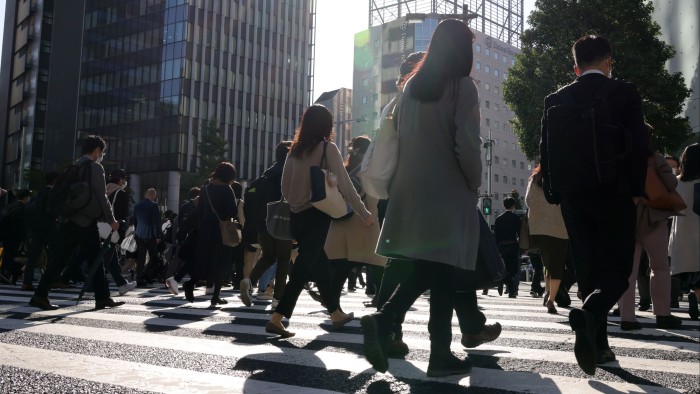
Elsewhere in the world, governments have tackled falling births with various measures and to varying degrees of success.
Some Japanese lawmakers have suggested learning from France, where households’ income taxes are reduced for every child and dependent. World Bank figures show France’s fertility rate — basically the average number of children a woman will have in her lifetime — dropped to about 1.7 in the 1990s but recovered to 2 in the 2000s. The figure slipped again during the pandemic but remains well above Japan’s roughly 1.3 in 2022.
A fertility rate of 2.1 is considered “replacement level”.
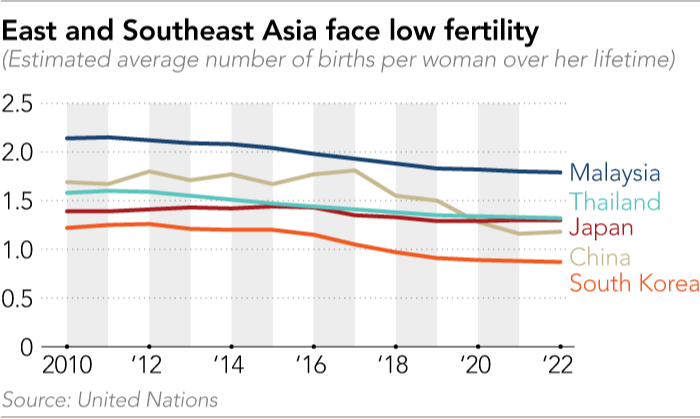
Elsewhere, South Korea this year started a significant upscaling of economic incentives. The government pays a Won700,000 ($538) monthly allowance to families with a baby younger than 1, and the amount will be increased to Won1mn next year.
In terms of sheer fertility, South Korea’s rate, at 0.87, is below Japan’s, according to UN estimates. Other economies, too, have lower rates, with Hong Kong at 0.76 and mainland China at 1.18. China last year had its first population decline in 61 years.
Some south-east Asian countries also have fertility rates that are below replacement level and falling: Thailand’s rate in 2022 was estimated at 1.32, down from 1.59 a decade earlier, while Malaysia’s was 1.79, down from 2.12. They are sure to be monitoring Japan’s progress.
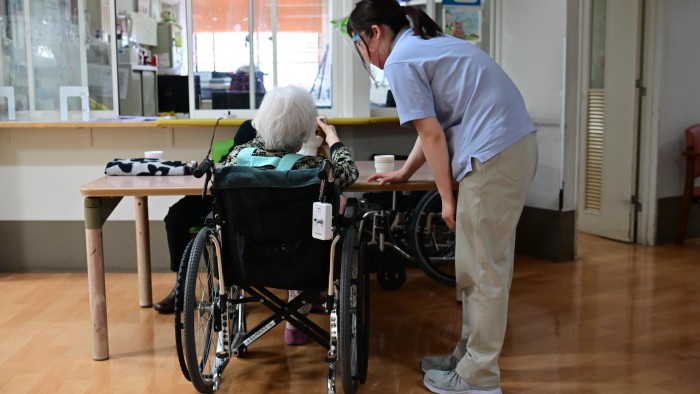
According to the JRI’s Fujinami, Japan can at least hope to tread water for a while.
“It will be very difficult for Japan to achieve a V-shaped recovery in the number of new births,” he said, arguing that the most optimistic scenario might be maintaining the 2022 level or a little higher for some years.
He said there was a chance of temporarily arresting the downtrend thanks to the relatively steady 1.2mn births per year recorded in the 1990s. This generation is now in their 20s and 30s and, as a result, the segment of women in their childbearing years is shifting slightly younger, he noted.
“With such a situation expected to continue until around 2030, we need to create an environment that facilitates childbearing for young people, thereby reducing the decline in births,” Fujinami said.
After a decade, the number of people of childbearing age is expected to fall faster.
Fujinami says there’s no time to lose. “Some may say it is already too late,” he said, “but I think we can say [the next decade] is the last hope.”
A version of this article was first published by Nikkei Asia on February 14 2023. ©2023 Nikkei Inc. All rights reserved.
Comments